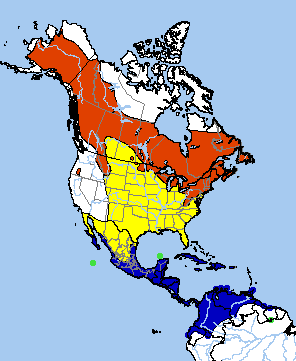Birdfinding.info ⇒ Generally common across much of its large, northerly breeding range. In winter, especially abundant in mangroves across much of the Caribbean region.
Northern Waterthrush
Parkesia noveboracensis
Breeds in boreal forests of North America. Winters from the southern U.S. to northern South America.
Breeding. Mainly in bogs and swamps across most of Alaska and Canada and south into the northern U.S. The northern limit extends beyond treeline into riparian thickets on the tundra. In the west, breeds southward in the Cascade and Rocky Mountains south to western Montana and at least sporadically to Oregon and Colorado. In the east, breeds south into the Great Lakes region, central Appalachians, and New England.
Nonbreeding. Winters most commonly in mangroves of the West Indies and Caribbean coast of Middle America. Also occurs in other moist wooded or brushy coastal habitats from southern California, southern Texas, and Florida to Ecuador, northern Amazonia, and the Guianas.
Movements. Northbound migration occurs mainly from late March to mid-May, and southbound from late July into October. Most migration is through the eastern U.S., but small numbers regularly occur throughout the western states as well. An occasional vagrant to western Europe and eastern Siberia.
Identification
One of two very similar species of largely terrestrial wood warblers with thrushlike plumage, a peculiar tail-bobbing gait, and a strong proclivity for wet habitats.
Northern Waterthrush is recognized by its off-white and often narrow eyebrow, heavily streaked underparts, and lack of contrast between flanks and rest of underparts. Compared to Louisiana Waterthush, Northern is more variable in many of its characteristics. (See below for more detailed information on separating Northern and Louisiana Waterthrushes.)

Northern Waterthrush—note yellowish, extensively streaked underparts, speckled throat, yellowish, tapering eyebrow, and dull pink legs. (Yaax Che Jardín Botánico del Dr. Alfredo Barrera Marín, Quintana Roo, Mexico; February 23, 2018.) © Ian Routley
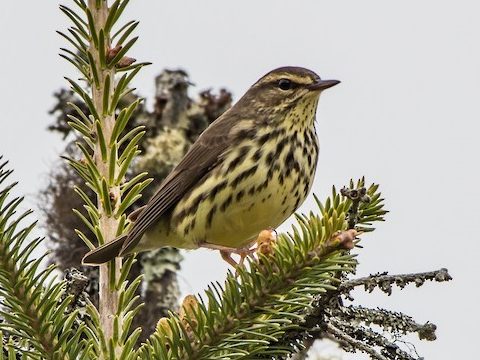
Northern Waterthrush—note yellowish, boldly streaked underparts, speckled throat, and yellowish, tapering eyebrow—although this individual also has pale pink legs. (Goulds, Newfoundland; May 26, 2018.) © Frank King

Northern Waterthrush—note yellowish, extensively streaked underparts, speckled throat, yellowish eyebrow, and dull pink legs. (Andree Clark Bird Refuge, Santa Barbara, California; April 15, 2018.) © Tom Benson
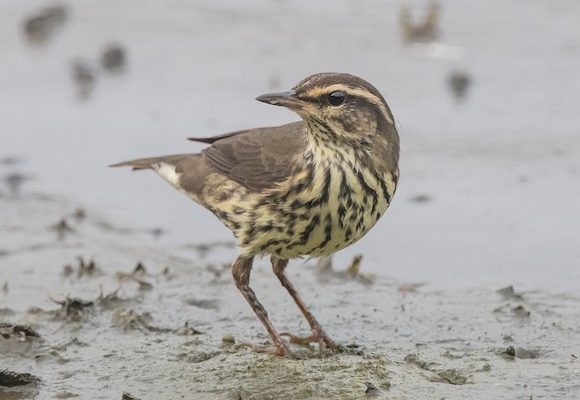
Northern Waterthrush—note yellowish, extensively streaked underparts, heavily streaked throat, yellowish eyebrow, and dark legs. (Mission Trails Regional Park, San Diego, California; September 11, 2018.) © Nancy Christensen

Northern Waterthrush—note yellowish underparts, streaked throat, and yellowish, tapering eyebrow—although this individual also has pale pink legs. (Oxen Pond Trail, St. John’s, Newfoundland; June 17, 2017.) © Pavel Parkhaev
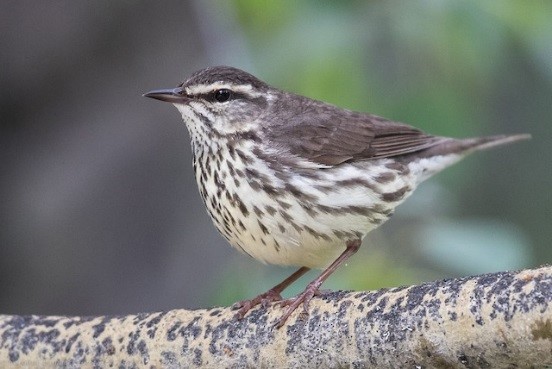
Northern Waterthrush—note narrow eyebrow and evenly whitish underparts without contrasting flanks. (Vermilion Lakes, Banff National Park, Alberta; June 15, 2016.) © Caroline Lambert
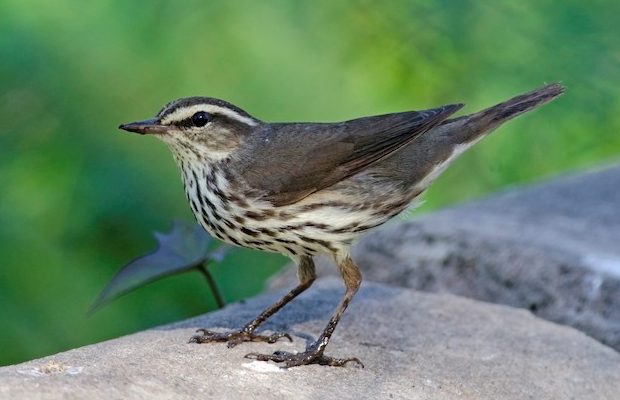
Northern Waterthrush—note dark gray legs and extensive bold streaking on underparts. (Criadero de Cocodrilos, Ciénaga de Zapata National Park, Cuba; February 13, 2017.) © Joshua D. Vandermeulen

Northern Waterthrush—note dark gray legs, extensive bold streaking on underparts, streaked throat, and narrow, yellowing eyebrow. (Garden Key, Dry Tortugas National Park, Florida; April 21, 2017.) © Max Wilson
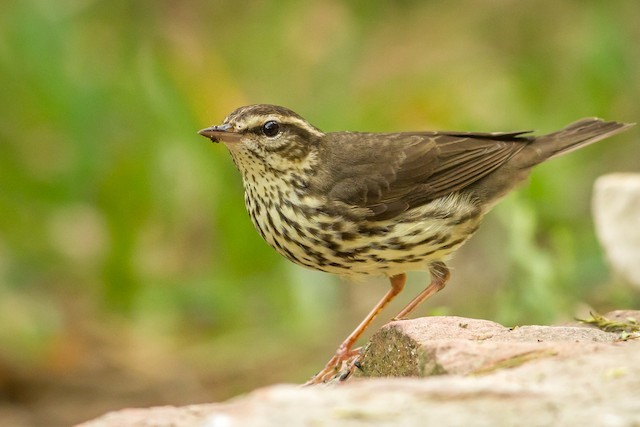
Northern Waterthrush, note yellowish, extensively streaked underparts, speckled throat and yellowish eyebrow—although this individual also has pale pink legs. (South Padre Island, Texas; April 16, 2013.) © Kyle Blaney
Cf. Louisiana Waterthrush. The two waterthrush species overlap widely during most of the year, and can be challenging to distinguish when not singing. Each has several distinctive traits, but both species are variable and some individuals are more intermediate than other. In many cases, identification requires multiple factors.
Following are the typical differences, but note that there is some overlap on every characteristic:
Eyebrow: Louisiana’s eyebrow is typically pure white and usually broadens behind the eye. Northern’s eyebrow is usually dingy white or yellowish and highly variable in extent—behind the eye it may either narrow or broaden or neither.
Legs: Louisiana’s are pale pink—often bright, “bubblegum” pink. Northern’s are usually grayish or dull pink, but can also be pale pink.

Northern Waterthrush—note mid-sized bill, even width of eyebrow, dark gray legs, and bold, sharp streaking on underparts. (Criadero de Cocodrilos, Matanzas, Cuba; February 13, 2017.) © Paul Tavares
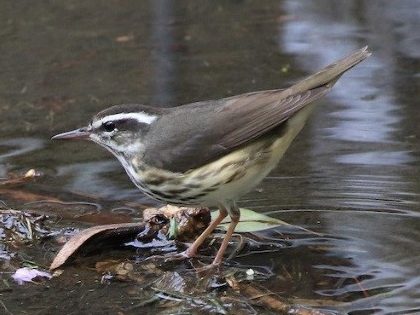
Louisiana Waterthrush—note long bill, broadening white eyebrow, pale pink legs, and diffuse streaking on underparts. (Gilman Park, Fullerton, California; September 16, 2017.) © Trish Gussler
Bill: Louisiana’s bill averages longer than Northern’s. This difference is difficult to assess in the field, usually most noticeable on long-billed individuals.
Throat: Louisiana’s throat is mostly unmarked, sometimes with a few speckles. Northern’s is streaked or speckled, often heavily.
Coloration of Underparts: Louisiana is mostly whitish below with a variable buffy or salmon-pinkish wash on the flanks. Northern’s underparts are usually the same color throughout, either whitish or yellowish.

Northern Waterthrush—note mid-sized bill and short, tapering eyebrow—but this individual also has pale pink legs and buffy flanks with somewhat diffuse streaking. (Falmouth, Jamaica; January 31, 2019.) © Matthew Grube

Louisiana Waterthrush—note long bill, buffy flanks, pink legs, and diffuse streaking on underparts—but its eyebrow is intermediate. (Sabine Woods, Texas Point National Wildlife Refuge, Texas; March 28, 2016.) © Harlan Stewart
Streaking on Underparts: The quantity and quality of streaking on the underparts is a highly variable characteristic—but it is diagnostic in many cases. As a rule, Louisiana is more sparsely streaked over a more limited area—mainly on the chest and sides—whereas Northern is densely streaked over most of its underparts, including much of the belly. The streaks on Northern are mostly bold, dark, and sharply defined, whereas Louisiana’s are comparatively diffuse (blurry), especially on the sides and flanks.
Tail-bobbing: Louisiana swings its tail in three dimensions. Northern teeters vertically.
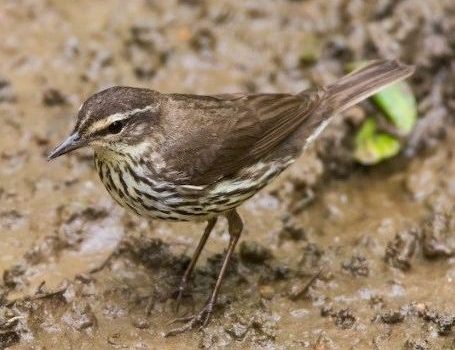
Northern Waterthrush—note tapering eyebrow, dark legs, and extensive bold, sharp streaking on underparts—but this individual appears to have an unstreaked throat. (Luria Park, Annandale, Virginia; May 6, 2018.) © Beth Fedorko
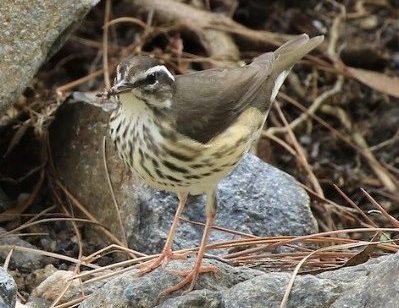
Louisiana Waterthrush—note bold white eyebrow, unstreaked throat, pink legs, and buffy flanks with diffuse streaks. (Gilman Park, Fullerton, California; September 16, 2017.) © Trish Gussler
Habitat: Louisiana favors running water, especially on its breeding grounds, but it also occur beside lakes and in swamps, especially on migration and winter grounds. Northern favors swamps, bogs, and lakeshores, but also occurs beside streams, and is sometimes found in dry habitats—where it often finds tiny rain puddles or patches of moist soil. On the wintering grounds, Northern is far more likely to be found in mangroves.
Among the many characteristics that can be used to identify waterthrushes, several are close to 100% diagnostic when clearly present. For example, any waterthrush with either dark gray legs, a tapering eyebrow, or a streaked throat is certainly Northern. Any waterthrush with a bright white eyebrow that broadens behind the eye, a noticeably long bill, or a salmon-buffy wash on the flanks is almost certainly Louisiana.
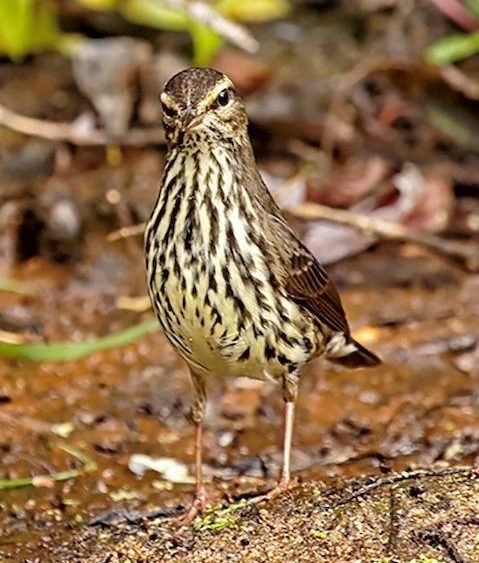
Northern Waterthrush, with heavily streaked underparts, including throat, and generally yellowish coloration of the underparts. (Carmel River mouth, Monterey, California; September 20, 2017.) © Bill Hill
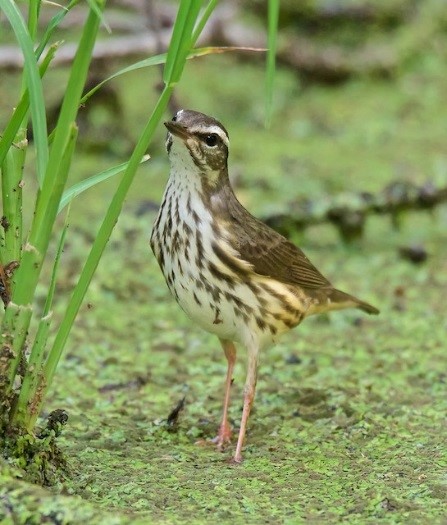
Louisiana Waterthrush, with sparsely streaked underparts, mostly unstreaked throat, and faintly buffy flanks. (Sabine Woods, Texas Point National Wildlife Refuge, Texas; April 27, 2017.) © Harlan Stewart
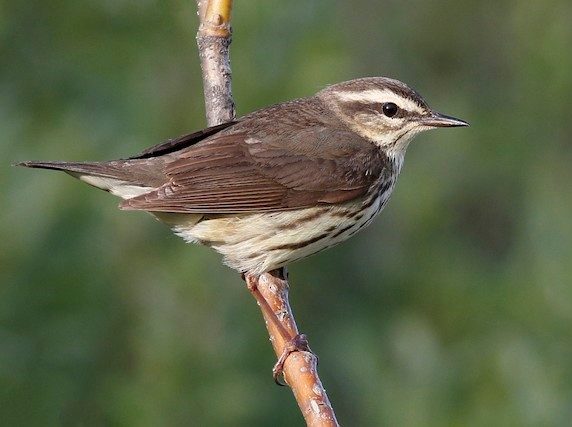
Northern Waterthrush, with pink legs, unusually broad whitish eyebrow, unstreaked throat, and somewhat diffuse streaking on flanks—generally resembling Louisiana—but note short bill and far northern location. (Nome, Alaska; June 9, 2016.) © Laura Keene
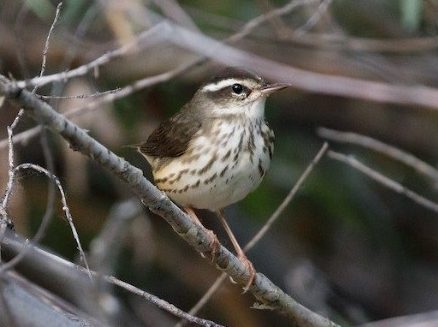
Louisiana Waterthrush, in Idaho, far out of its normal range—note broad white eyebrow, pink legs, buffy flanks, limited streaking on underparts, and unstreaked throat. (Ketchum, Idaho; July 16, 2018.) © Darren Clark

Northern Waterthrush, with pale pink legs, very limited speckling on throat, and intermediate streaking on underparts—but note yellowish coloration of underparts and eyebrow. (Sussex, Delaware; September 10, 2016.) © Bob Edelen
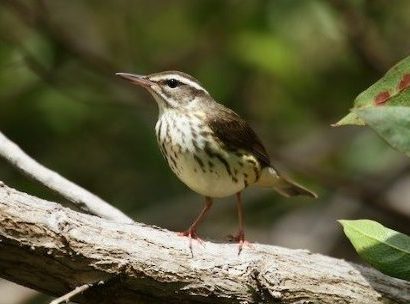
Louisiana Waterthrush, at an unusual location for mid-April—but note very long bill. (Charles “Sonny” McCoy Indigenous Park, Key West, Florida; April 19, 2017.) © Patrick J. Blake
Notes
Monotypic species.
References
Alderfer, J., and J.L. Dunn. 2014. National Geographic Complete Birds of North America (Second Edition). National Geographic Society, Washington, D.C.
Ascanio, D., G.A. Rodriguez, and R. Restall. 2017. Birds of Venezuela. Christopher Helm, London.
Dunn, J.L., and K.L. Garrett. 1997. A Field Guide to Warblers of North America. Houghton Mifflin, Boston.
eBird. 2019. eBird: An online database of bird distribution and abundance. Cornell Lab of Ornithology, Ithaca, N.Y. http://www.ebird.org. (Accessed March 23, 2019.)
ffrench, R. 2012. A Guide to the Birds of Trinidad & Tobago (Third Edition). Cornell University Press, Ithaca, N.Y.
Garrido, O.H, and A. Kirkconnell. 2000. Field Guide to the Birds of Cuba. Cornell University Press, Ithaca, N.Y.
Garrigues, R., and R. Dean. 2014. The Birds of Costa Rica: A Field Guide (Second Edition). Cornell University Press, Ithaca, N.Y.
Haynes-Sutton, A., A. Downer, R. Sutton, and Y.-J. Rey-Millet. 2009. A Photographic Guide to the Birds of Jamaica. Princeton University Press, Princeton, N.J.
Howell, S.N.G., and S. Webb. 1995. A Guide to the Birds of Mexico and Northern Central America. Oxford University Press, Oxford.
Latta, S., C. Rimmer, A. Keith, J. Wiley, H. Raffaele, K. McFarland, and E. Fernandez. 2006. Birds of the Dominican Republic and Haiti. Princeton University Press, Princeton, N.J.
Raffaele, H. 1989. A Guide to the Birds of Puerto Rico and the Virgin Islands. Princeton University Press, Princeton, N.J.
Raffaele, H., J. Wiley, O. Garrido, A. Keith, and J. Raffaele. 1998. A Guide to the Birds of the West Indies. Princeton University Press, Princeton, N.J.
Ridgely, R.S., and J.A. Gwynne. 1989. A Guide to the Birds of Panama (Second Edition). Princeton University Press, Princeton, N.J.
Ridgely, R.S., and G. Tudor. 2009. Field Guide to the Songbirds of South America: The Passerines. University of Texas Press, Austin.
Salt, W.R., and J.R. Salt. 1976. The Birds of Alberta. Hurtig Publishers, Edmonton, Alberta.
Wells, J.V., and A.C. Wells. 2017. Birds of Aruba, Bonaire, and Curaçao. Cornell University Press, Ithaca, N.Y.
Wikiaves, Mariquita-boreal, https://www.wikiaves.com.br/mariquita-boreal.

